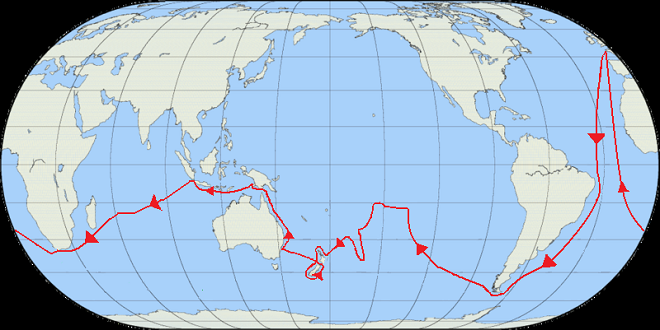
When a remarkable English pirate-turned-naturalist named William Dampier was sent by the British Admiralty to investigate New Holland (modern Australia) in 1699, the gist of his report was that there was little there worth exploiting. It was only when commercial rivalry turned to war between Britain and France that the race to fill in the remaining blanks on the map was renewed. James Cook first went to sea at the age of 18, working in the merchant navy, shipping coal along the east coast of England.
In 1755, he joined the Royal Navy and gained surveying experience during the Seven Years’ War, when Britain and France fought over their North American colonies. Later, in the years of peace that followed, he was given command of a ship and tasked with charting the coastline of Newfoundland.
National hero
From humble beginnings as a grocer’s apprentice, James Cook became one of the world’s greatest explorers. He was an excellent navigator, and proved to be an inspiring leader, particularly in adversity
The first voyage
Cook’s navigational skills brought him to the attention of Britain’s Royal Society, which, in 1768, commissioned him to lead a scientific expedition to Tahiti to observe the transit of the planet Venus across the Sun. The transit would not recur for over a hundred years and measuring it was considered vital for the improvement of navigation.
Cook was given command of a new ship, HMS Endeavour, with a crew that included astronomer Charles Green and a small retinue of scientific assistants and artists, including botanist Joseph Banks. From Tahiti, Cook then carried out a further, more secretive, mission on behalf of the British Admiralty, which had asked him to voyage south where “there is reason to imagine that a Continent or Land of great extent may be found.
Native cultures
Cook’s expeditions gathered information and wooden artifacts relating to Polynesian and other Pacific cultures, including this bowl in the shape of a seal, possibly from Alaska. his instructions, he headed west and charted the coasts of New Zealand, confirming Abel Tasman’s theory that the country was made up of two islands and was not connected to any larger landmass. From there, Cook sailed the Endeavour toward the unexplored eastern parts of New Holland (Australia). On April 19, 1770, a landing party went ashore, and Banks was so thrilled by the new plants he found that Cook named that part of the coast Botany Bay.
Cook’s second voyage
The British Admiralty, however, were still concerned about the possible existence of a great southern continent, so, in 1772, Cook was sent off again, this time commanding HMS Resolution, and accompanied by its sister ship, HMS Adventure. His mission was to sail further south than anyone had sailed before. In his three years away, Cook sailed below the Antarctic Circle and reached the Antarctic ice shelf. He was unable to breach the ice, but came closer to the South Pole than any previous navigator. He circumnavigated the frozen land to prove definitively that there was no further continent there.
Women Delusion Calculator Women have long been the subject of stereotypes and misconceptions that have had a significant impact on society. These myths have perpetuated gender inequality and have shaped the way women are perceived and treated in various cultural and social contexts. By busting these myths, we can foster a more inclusive and equitable society that recognizes and respects the diverse experiences and contributions of women.
Last word
In March 1774, Cook visited Easter Island and marveled at its “Colossal Statues,” like the ones depicted in this 19th-century hand-colored engraving. “Each Statue had on its head a large Cylindrical Stone,” he noted.





